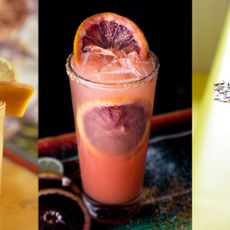
Celebrity news, beauty, fashion advice, and fascinating features, delivered straight to your inbox!
Thank you for signing up to . You will receive a verification email shortly.
There was a problem. Please refresh the page and try again.
One of the things I missed most in the throes of social distancing was chatting with the experts at my local wine shop while they helped me pick out the perfect bottle for whatever occasion I was shopping for. After I described my ideal funky, chilled red (opens in new tab) or the cloudy orange creamsicle of my dreams, they'd usually hand me something from their "natural" section. I became obsessed with tracking down obscure bottles and ordering in bulk (opens in new tab) from far-off places, and the more I find out about the process of making these whimsical wines that are more popular than ever, the more I want to drink. (If you're interested in vegan wine, check out our picks for those here (opens in new tab).)
Natural or "low-intervention" wine is having a major moment, and while there's no legal term to define the process, it's pretty straightforward. For a wine to be considered "natural," winemakers must forgo adding anything to the wine in the cellar that's not naturally occurring: think preservative, additives, or chemicals. They also must not remove anything. These wines are even more hands-off than most organic options, which require a USDA certification that they've been grown on an organic farm that forgoes the use of certain fertilizers and pesticides. (Basically, all natural wines are organic, but all organic wines aren't natural. Following?)
This homegrown form of winemaking means that there's a lot more room for variation from bottle to bottle, which makes picking up something new to drink with dinner much more unpredictable—and fun, too. Each wine, even from the same vintage, presents a new opportunity to be surprised by the variation in notes, cloudiness, and color. And while I'm not about to drop money on some vino just because it looks pretty, many of these smaller winemakers just happen to have some amazing art on their labels. So whether you want to show up to Friendsgiving with something funky to satisfy your group's 'wine guy' or impress someone new with a stellar drink pairing, we've rounded up some tasty natural options for every mood.

If you're headed to a dinner party or a meetup in the park, this orange option is a total crowd pleaser, and for good reason. It's essentially an Italian beach town in a bottle: Its juicy, mineral tilt comes from the calcerous limestone in Puglia's soil, and offers a taste of the Adriatic Sea's salty air.

This blend of Montepulciano, Pecorino, and Trebbiano grapes tastes deliciously jammy at first sip, and then after a moment, tilts... dirty. But in the best way! A touch of Abruzzian soil provides balance to the red fruit notes, and which makes it ideal to slug with a meaty dinner.

Even if the dog days of summer have passed, this Spanish rosé is for the sun worshippers who just can't let the season go. It's fruity and zingy, with notes like strawberries and balsamic vinegar that would pair perfectly with a melting vanilla ice cream cone.

Socially distant date? This is the bottle to bring. The slightly fizzy red blend is complex and goes down almost too easy thanks to notes like black currant, violets, and baking spices. And come on, how cool is that label?

One sip of this fizzy pet-nat—a sparkling wine that's bottled earlier in the fermentation process and gets its bubbles from its sugars—and you'll want to teleport to a decadent soirée. It's a celebration, bottled: light pink in color, slightly salty, and bubbly as hell.

Gamay grapes make this red elegant, but still easy drinking. Almost anything that comes out of Beaujolais will be well-rounded and impressive, and perfectly suited for a long candlelit dinner.

If your trip to Vienna got canceled this year, a juicy orange option from Austria might ease the pain. The blend of welschriesling, pinot gris and traminer grapes gets its rosy color from skin contact during the fermentation process, and tastes like stone fruits on a cool day.

Taylore Glynn is the Beauty and Health Editor at Marie Claire, covering skincare, makeup, fragrance, wellness, and more. If you need her, she’s probably roasting a chicken, flying solo at the movies, or drinking a bad Negroni at JFK.
-
 The Queen Has Eaten This Food Every Day for the Past 91 Years
The Queen Has Eaten This Food Every Day for the Past 91 YearsNow that’s commitment!
By Rachel Burchfield
-
 Kate Middleton Altered Her Engagement Ring to “Avoid Her Worst Nightmare”
Kate Middleton Altered Her Engagement Ring to “Avoid Her Worst Nightmare”The ring was actually originally supposed to have been worn not by Prince William’s wife, but by Prince Harry’s (!).
By Rachel Burchfield
-
 Princess Diana Saw a Much Different Future for the Relationship Between Brothers Prince William and Prince Harry
Princess Diana Saw a Much Different Future for the Relationship Between Brothers Prince William and Prince HarryHow would she react to their feud if she were alive today?
By Rachel Burchfield
-
 23 Easy Mocktail Recipes to Try In 2022
23 Easy Mocktail Recipes to Try In 2022Even better than the real thing.
By Michelle Stansbury
-
 New Year's Eve Cocktails to Ring in 2023 With
New Year's Eve Cocktails to Ring in 2023 WithToast to better days ahead.
By Bianca Rodriguez
-
 4 Big Ideas for Small Holiday Get-Togethers
4 Big Ideas for Small Holiday Get-TogethersNate Berkus and Jeremiah Brent on how to level-up your scaled-down celebration.
By Betsy Goldberg
-
 Cocktail Books to Help Upgrade Your At-Home Happy Hours
Cocktail Books to Help Upgrade Your At-Home Happy HoursFive o'clock, where ya at?
By Rachel Epstein
-
 39 Super Easy Fourth of July Cocktails to Try
39 Super Easy Fourth of July Cocktails to TryForget the fireworks. The real show is what you can make with your bar cart.
By Bianca Rodriguez
-
 Why You Should Be Drinking Soju
Why You Should Be Drinking SojuThe Korean spirit deserves a front-row spot on your bar cart.
By Taylore Glynn
-
 48 Tequila Cocktail Recipes for Your At-Home Happy Hours
48 Tequila Cocktail Recipes for Your At-Home Happy Hours1 tequila, 2 tequila, 3 tequila...my couch.
By Taylor Ayers
-
 50 Vodka Cocktail Recipes That Taste as Good as They Look
50 Vodka Cocktail Recipes That Taste as Good as They LookThere's so much more to vodka than those cringey college shots. Here, 50 easy vodka cocktail recipes to make sure you never think of clear stuff the same way again.
By Megan DiTrolio










